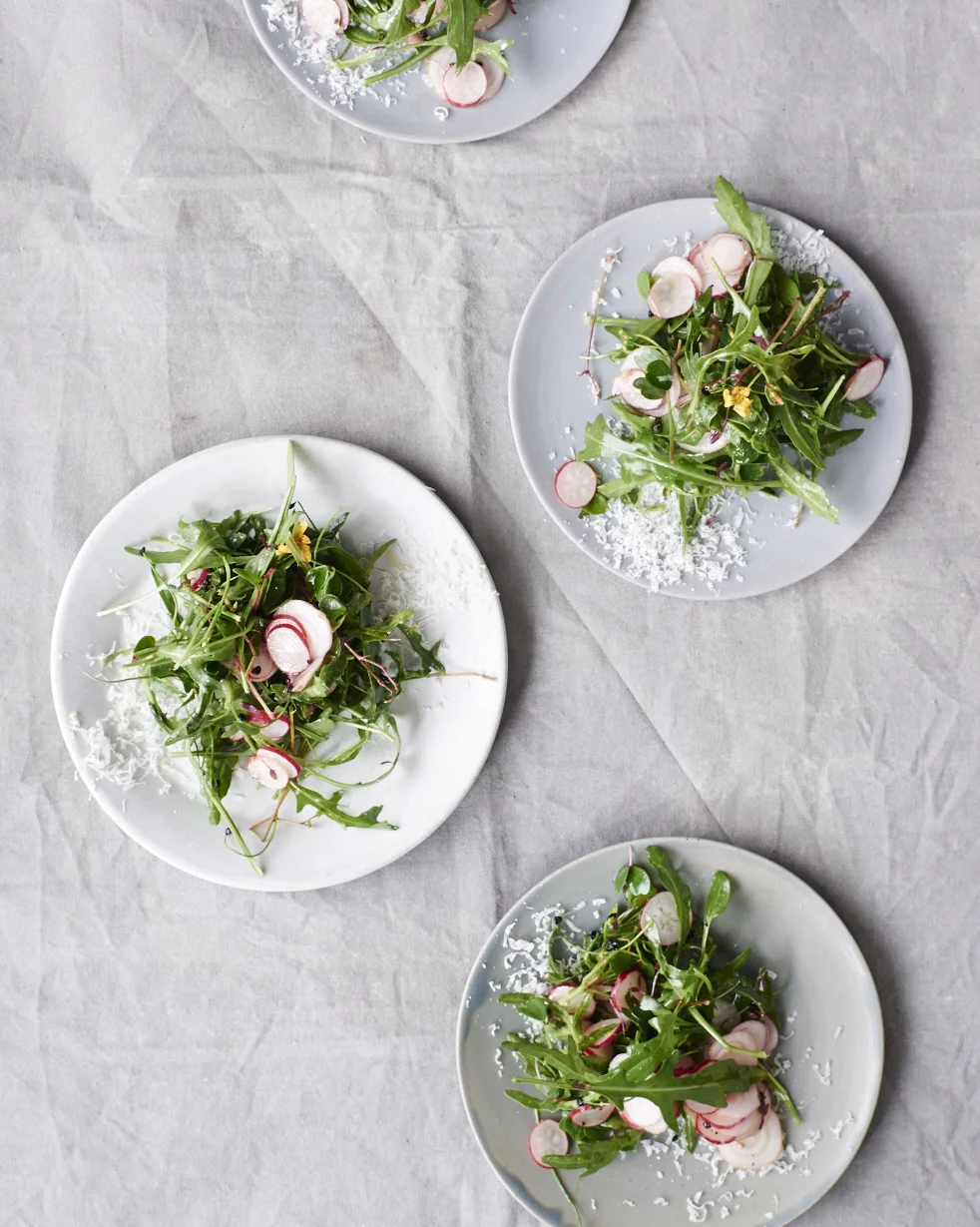Be still my heart: Radishes!
So cute, they’re adorable! But so brash. They can be a little bossy, a little assertive. A wake up call! Of course I’m talking about radishes, the charming but somewhat overlooked actors waiting in the wings of our kitchen stage. Let’s talk about their myriad facets, and the many roles they are ready to play on our plates!
A bit of radish history
Radish plants are native to China, and are thought to have been cultivated in Europe as early as Neolithic times (from around 9,000 to 3,000 BC). They were certainly eaten in Egypt since the beginning of civilization. The 100,000 builders of The Great Pyramid evidently ate enormous quantities of radishes together with onions and leeks. The mind boggles.
Today’s familiar red globe radishes first appeared on the food scene in the 18th century, and now there are more than 250 varieties in various shapes, sizes and colors. A veritable treasure trove of radishes!
An array of color
There are many radish varieties available for purchase, both as seeds and produce. Some are quite mild, some are very peppery. They come in a myriad of colors:
Cherry red globe radishes, the most common, but uncommonly good at adding snap and color to salads
Easter egg radishes, purple, white, pink and red
French breakfast radishes, finger-length, cherry red dipped in white
Japanese daikon radishes, white winter radishes 6 inches to a foot long. They look like fat carrots, and are a wonderful addition to a cook’s repertoire—pungent, juicy, delicious grated or spiralized. Refreshing! Play with these if you haven’t yet.
Black radishes, very pungent, great with cheeses. These store really well.
Watermelon radishes, my favorite. With a thin green skin on the outside and a watermelon pink center, these are delicious sliced super thin and gorgeous arrayed on a plate. A work of art at the snap of your fingers!
One of the easiest plants to grow, radishes are a rewarding choice for backyard gardeners. Enjoy photos of just a few varieties offered by the Seed Savers Exchange.
In case you are curious, no! Horseradish is not a radish. The two plants are different species, but both are in the brassica family.
Nutritional Benefits
Radishes are nutrient-dense! They’re anti-bacterial, anti-fungal, and also nature’s diuretic. They help flush things out. They contain a plant chemical that is really good for dissolving mucus or phlegm and also particularly good for cleansing and expelling gallstones and kidney stones. They are also good for hoarseness, sinuses, and sore throats. They contain a lot of enzymes that help us salivate and secrete digestive juices—especially helpful if you are eating starchy foods.
A radish primer
When purchasing, select well formed, firm, young radishes. These will tend to be mild and crisp. When too old, radishes get woody, spongy, and too peppery. You want them crisp and crunchy.
I remember every night when my father came home from the office, he would sit and eat a little plate of radishes before dinner. He’d sprinkle on a little salt and pop them in his mouth like bon bons. Also I remember growing up seeing them on crudite platters. My mom used to take her knife and turn them into flowers (remember those?) and serve them In a bowl with celery and carrots. But I like to pair them with MANY different things.
Beyond Recipes
Try serving them:
- Raw. The best way to eat a radish raw? Dipped in olive oil with a little sea salt. Or like the French do it, with a little butter and sea salt.
- Roasted. Like all roots, they become mellower when roasted.
- Pickled. These are nice to have on hand to add to salads.
- On greens.
- Spiralized. I love to spiralize daikon radish into thin noodles and garnish it with fish. The fattiness of fish with that crispy, clean taste of radish is a lovely pairing.
- As a garnish. Sprinkled on a salad with avocado or edamame. Biting into those pieces of radish is like a sparkle of sunshine, a breath of fresh air.
- On sandwiches. Picture open-faced, whole-grain pumpernickel and chevre sandwiches with sliced radish and snips of dill on top. So pretty! Add to any sandwich for a clean, bracing tang.
- With:
- Parsley and sea salt
- Avocados, pumpkin seeds and salad greens
- Orange, mint and salad greens
- A little yogurt and garlic
- Butter and salt
- Slaws!
- Cabbage, celery, salt and onion
- Cucumber and dill
- Cilantro, lime and olive oil
- Fennel and lemon
If radish were a volume, it would be loud and clear! Like walking out on a brisk spring morning when a breeze catches you. That’s a radish. Unless they are roasted. :) In which case, the more mellow delights come to the forefront.
Try adding roasted radishes to an avocado, arugula and mint salad...
Recipes
It was SO much fun taste-testing and collaborating with my friend and colleague Andy Weil on his beautiful book Fast Food, Good Food. He is the real deal when it comes to food—a gardener, food connoisseur, and nutritionist par excellence. He’s very fun to cook and teach with!
This is his simple summer radish salad. And you know how simple, in the hands of a maestro, can be the MOST memorable? With thinly sliced radish, fresh sprouts, lemon vinaigrette and a little shaved parm, this is one of those.
I use radishes all the time, but looking through my five cookbooks you’d never know that. I’m fixing that omission, right here, right now by amending my Avocado Lover’s Salad from The Longevity Kitchen—adding that radish ray of sunshine to the already delectable blend of avocado, cucumber, pumpkin seeds, fresh mint and cilantro. An easy summer stunner!




